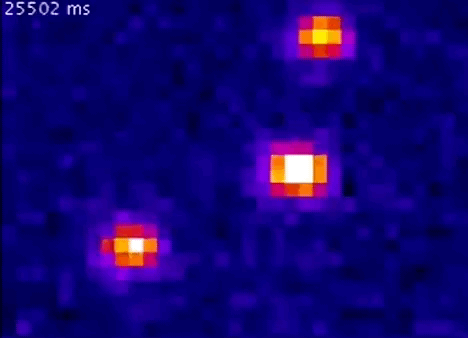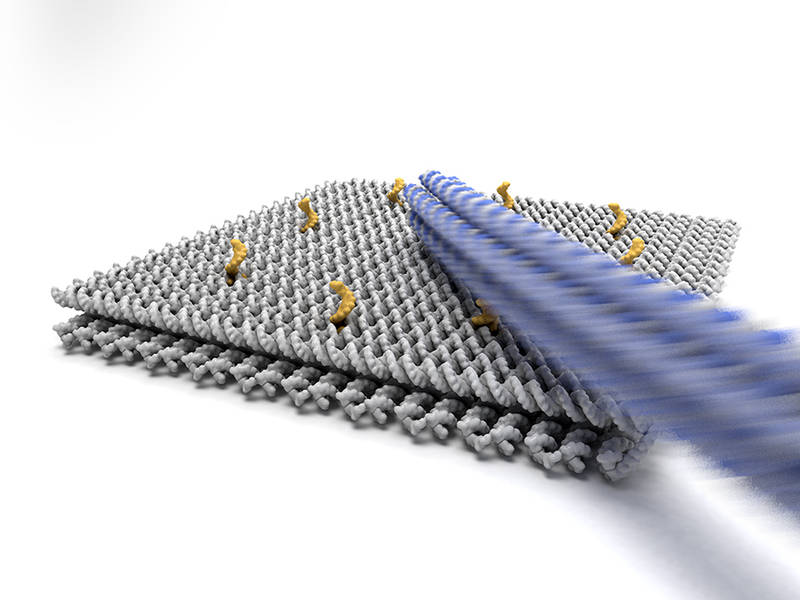
25th January 2018 100,000-fold increase in molecular machine speed A new propulsion method for molecular machines enables them to be moved 100,000 times faster than biochemical processes used to date.
Scientists at the Technical University of Munich (TUM) have developed a novel electric propulsion technology for nanorobots. It allows molecular machines to move 100,000 times faster than with biochemical processes used to date. According to the researchers, this makes nanobots fast enough to do assembly line work in molecular factories. The breakthrough is featured as the cover story this month in the renowned scientific journal Science. Professor Friedrich Simmel, head of Synthetic Biological Systems at TUM, uses a fluorescence microscope to observe and control the movement of nanomachines that are visible as glowing dots, affixed to the ends of tiny robot arms. A simple mouse click is all it takes for the points of light to move in another direction. "By applying electric fields, we can arbitrarily rotate the arms in a plane," he explains. His team has, for the first time, managed to control nanobots electrically while also setting a new speed record, orders of magnitude faster than all previous methods.
Scientists around the world are working on new technologies that could be used in "nanofactories" of the future. These devices would enable the rapid assembly and replication of products with extreme precision – such as nano-medicines, advanced materials, or complex electronics. The molecular machines required for this process can already be produced cost-effectively using the DNA origami technique. The only reason they have not been deployed on a large scale to date is that they are too slow. The building blocks are activated with enzymes, strands of DNA or light to then perform specific tasks, such as gathering and transporting molecules to new locations. Conventional nanobots take minutes and sometimes even hours to carry out these actions. Efficient molecular assembly lines cannot, for all practical intents and purposes, be implemented using these methodologies. "Building up a nanotechnological assembly line calls for a different kind of propulsion technology," explains Professor Simmel. "We came up with the idea of dropping biochemical nanomachine switching completely in favour of the interactions between DNA structures and electric fields." The principle behind the new propulsion technology is simple: DNA molecules have negative charges. The biomolecules can therefore be moved by applying electric fields. Theoretically, this should allow nanobots made of DNA to be steered using electrical impulses.
To determine whether and how fast the robot arms would line up with an electric field, the researchers affixed several million nanobot arms to a glass substrate and placed this into a sample holder with electrical contacts. Each of these tiny machines consisted of a 400 nanometre (nm) arm, attached to a 55 by 55 nm base plate with a flexible joint made of unpaired bases. This construction ensured that the arms could rotate arbitrarily in the horizontal plane. In collaboration with fluorescence specialists, headed by Professor Don Lamb from the Ludwig-Maximilian University of Munich, the researchers "painted" the tips of these robot arms using pigment molecules. This allowed them to observe their motion using a fluorescence microscope. They then changed the direction of the electric field, to arbitrarily alter the orientation of the arms and control the locomotion process. "The experiment demonstrated that molecular machines can be moved, and thus also driven electrically," says Simmel. "Thanks to the electronic control process, we can now initiate movements on a millisecond time scale and are thus 100,000 times faster than with previously used biochemical approaches."
Comments »
If you enjoyed this article, please consider sharing it:
|








